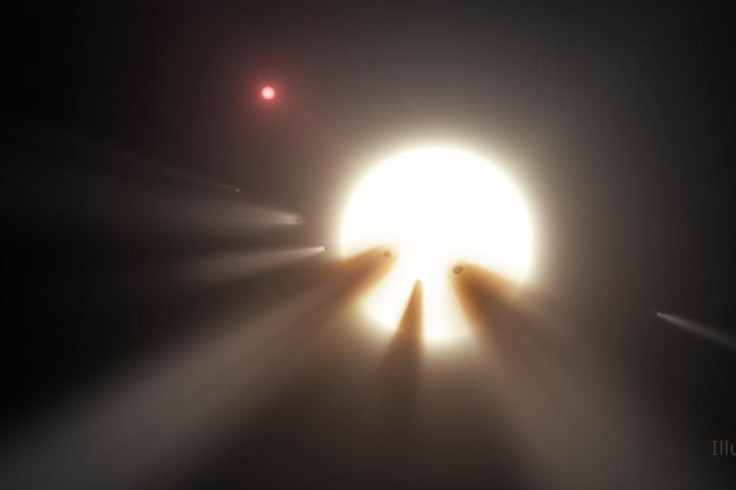‘Alien Megastructure’ Star Update: Interstellar Junk May Explain Tabby’s Star’s Weird Behavior, Study Says

No other star has captured people's imagination in recent years quite like KIC 8462852 has. The erratic behavior of the star, located 1,400 light-years from Earth between the constellations Cygnus and Lyra, has spawned fevered speculation among both the scientific community and the general public.
Among the more outlandish "theories" put forward to explain the star's behavior is one that posits the existence of an "alien megastructure" around it — a Dyson sphere of sorts, built by technologically advanced extraterrestrials to harness the star's energy.
However, according to a new paper — the latest of many published over the past year that have attempted to explain the oddity — one need not invoke the presence of an alien megastructure to explain the star's behavior. The authors of the study, which is yet to be peer-reviewed, argue that interstellar junk may be what's causing the inexplicable dips in the star's brightness.
Before we delve into the findings of the new study, here's the story so far:
Last fall, a team of scientists led by Tabetha Boyajian from Yale University, who lends the star its informal name — “Tabby’s star” — reported that the object was not behaving as it should. Based on observations conducted using NASA's Kepler Space Telescope between 2009 and 2013, the team witnessed two unusual incidents, one each in 2011 and 2013, when the star's light dimmed in dramatic, never-before-seen ways.
This dimming indicated that something had passed in front of the star. At the time, a swarm of comets was proposed as the most likely explanation.
However, this is not when Tabby’s star captured the public’s imagination. That happened a month later, in October 2015, when Jason Wright, an astronomer from Penn State University, put forth the idea that the swarm of objects around the star is “something you would expect an alien civilization to build.”
Unfortunately, two subsequent independent searches, especially tailored to detect alien radio signals and laser pulses, drew a blank. Earlier this year, a study based on analysis of photographic plates of the sky dating back to the late 19th century, argued that even the comet swarm idea, which was the best of the remaining proposals, cannot explain the star’s erratic dimming — although the study’s findings were widely disputed.
Most recently, in a paper published last month, Caltech astronomer Ben Montet and Joshua Simon of the Carnegie Institute detailed their analysis of photometric data of the star gathered by the Kepler space telescope. They found that the star was definitely dimming at a rate that defies explanation over the four years Kepler monitored it. For instance, in the first 1,000 days of Kepler’s observations, the star’s luminosity dipped by roughly 3.4 percent per year, before dropping dramatically by 2.5 percent in a span of just 200 days — something that suggests the long-term dimming hypothesis may very well be true.
The study ruled out all the possible, non-E.T. explanations that have been put forward so far — a swarm of comets, planetary fragments or a distorted star, and the new paper does the same for the Dyson sphere hypothesis.
Authored by Valeri Makarov from the U.S. Naval Observatory in Washington, D.C., and Alexey Goldin from Teza Technologies in Chicago, the paper argues that the intriguing dips in the star's brightness are not a result of something around the star itself, but are being caused by interstellar clutter. They say that this junk — which may be a swarm of "interstellar comets"— is also causing slight dips in the brightness of a different star, yet to be detected, lying in the same line of sight.
If another star is also dimming, the argument goes, it obviously can’t be anything around Tabby’s star alone that's blocking the light.
The problem is, no interstellar comets have ever been detected. Also, this doesn't explain the massive 20 percent dip that scientists have observed in the star's brightness over the past 100 years.
"Maybe interstellar space is full of free-floating comets," Makarov told New Scientist. "But try to find them! They are dark and cold, and travelling from nowhere to nowhere, basically, forever."
© Copyright IBTimes 2025. All rights reserved.






















